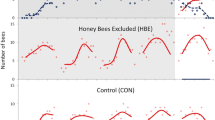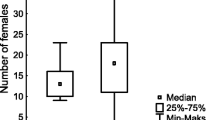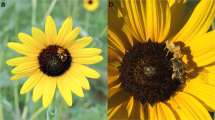Abstract
In the absence of predators, pollinators can often maximize their foraging success by visiting the most rewarding flowers. However, if predators use those highly rewarding flowers to locate their prey, pollinators may benefit from changing their foraging preferences to accept less rewarding flowers. Previous studies have shown that some predators, such as crab spiders, indeed hunt preferentially on the most pollinator-attractive flowers. In order to determine whether predation risk can alter pollinator preferences, we conducted laboratory experiments on the foraging behavior of bumble bees (Bombus impatiens) when predation risk was associated with a particular reward level (measured here as sugar concentration). Bees foraged in arenas containing a choice of a high-reward and a low-reward artificial flower. On a bee’s first foraging trip, it was either lightly squeezed with forceps, to simulate a crab spider attack, or was allowed to forage safely. The foragers’ subsequent visits were recorded for between 1 and 4 h without any further simulated attacks. Compared to bees that foraged safely, bees that experienced a simulated attack on a low-reward artificial flower had reduced foraging activity. However, bees attacked on a high-reward artificial flower were more likely to visit low-reward artificial flowers on subsequent foraging trips. Forager body size, which is thought to affect vulnerability to capture by predators, did not have an effect on response to an attack. Predation risk can thus alter pollinator foraging behavior in ways that influence the number and reward level of flowers that are visited.




Similar content being viewed by others
References
Abbott KR (2006) Bumblebees avoid flowers containing evidence of past predation events. Can J Zool 84:1240–1247
Abbott KR, Dukas R (2009) Honeybees consider flower danger in their waggle dance. Anim Behav 78:633–635
Andersson S (2003) Foraging responses in the butterflies Inachis io, Aglais urticae (Nymphalidae), and Gonepteryx rhamni (Pieridae) to floral scents. Chemoecology 13:1–11
Bachman WW, Waller GD (1977) Honeybee responses to sugar solutions of different compositions. J Apic Res 16:165–169
Baude M, Dajoz I, Danchin E (2008) Inadvertent social information in foraging bumblebees: effects of flower distribution and implications for pollination. Anim Behav 76:1863–1873
Bednekoff PA (2007) Foraging in the face of danger. In: Stephens DW, Brown JS, Ydenberg RC (eds) Foraging: behavior and ecology. The University of Chicago Press, Chicago, pp 305–329
Brechbuhl R, Casas J, Bacher S (2010a) Ineffective crypsis in a crab spider: a prey community perspective. Proc R Soc B Biol Sci 277:739–746
Brechbuhl R, Kropf C, Bacher S (2010b) Impact of flower-dwelling crab spiders on plant–pollinator mutualisms. Basic Appl Ecol 11:76–82
Brown JS, Kotler BP (2007) Foraging and the ecology of fear. In: Stephens DW, Brown JS, Ydenberg RC (eds) Foraging: behavior and ecology. The University of Chicago Press, Chicago, pp 437–480
Chien SA, Morse DH (1998) The roles of prey and flower quality in the choice of hunting sites by adult male crab spiders Misumena vatia (Araneae, Thomisidae). J Archnol 26:238–243
Clark CW, Dukas R (1994) Balancing foraging and antipredator demands—an advantage of sociality. Am Nat 144:542–548
Cruden RW, Hermann SM, Peterson S (1983) Patterns of nectar production and plant–pollinator coevolution. In: Bentley B, Elias T (eds) The biology of nectaries. Columbia University Press, New York
Dukas R (2001a) Effects of perceived danger on flower choice by bees. Ecol Lett 4:327–333
Dukas R (2001b) Effects of predation risk on pollinators and plants. In: Chittka L, Thompson JD (eds) Cognitive ecology of pollination. Cambridge University Press, Cambridge, pp 214–236
Dukas R, Morse DH (2003) Crab spiders affect flower visitation by bees. Oikos 101:157–163
Gadagkar R (1990) Evolution of eusociality—the advantage of assured fitness returns. Philos Trans R Soc Lond B Biol Sci 329:17–25
Gonçalves-Souza T, Omena PM, Souza JC, Romero GQ (2008) Trait-mediated effects on flowers: artificial spiders deceive pollinators and decrease plant fitness. Ecology 89:2407–2413
Goulson D, Peat J, Stout JC, Tucker J, Darvill B, Derwent LC, Hughes WOH (2002) Can alloethism in workers of the bumblebee, Bombus terrestris, be explained in terms of foraging efficiency? Anim Behav 64:123–130
Heiling AM, Cheng K, Herberstein ME (2004) Exploitation of floral signals by crab spiders (Thomisus spectabilis, Thomisidae). Behav Ecol 15:321–326
Heiling AM, Herberstein ME (2004) Floral quality signals lure pollinators and their predators. Ann Zool Fenn 41:421–428
Higginson AD, Gilbert FS, Barnard CJ (2006) Morphological correlates of nectar production used by honeybees. Ecol Entomol 31:269–276
Hugie DM, Dill LM (1994) Fish and game—a game-theoretic approach to habitat selection by predators and prey. J Fish Biol 45:151–169
Ings TC, Chittka L (2008) Speed–accuracy tradeoffs and false alarms in bee responses to cryptic predators. Curr Biol 18:1–5
Ings TC, Chittka L (2009) Predator crypsis enhances behaviourally mediated indirect effects on plants by altering bumblebee foraging preferences. Proc R Soc B Biol Sci 276:2031–2036
Jandt JM, Dornhaus A (2009) Spatial organization and division of labour in the bumblebee Bombus impatiens. Anim Behav 77:641–651
Jones EI (2010) Optimal foraging when predation risk increases with patch resources: an analysis of pollinators and ambush predators. Oikos 119:835–840
Møller AP (1995) Bumblebee preference for symmetrical flowers. Proc Natl Acad Sci USA 92:2288–2292
Morse DH (1979) Prey capture by the crab spider Misumena calycina (Araneae, Thomisidae). Oecologia 39:309–319
Morse DH (1981) Prey capture by the crab spider Misumena vatia (Clerck) (Thomisidae) on three common native flowers. Am Midl Nat 105:358–367
Morse DH (1988) Cues associated with patch-choice decisions by foraging crab spiders Misumena vatia. Behaviour 107:297–313
Morse DH (2007) Predator upon a flower: life history and fitness in a crab spider. Harvard University Press, Cambridge
Morse DH, Fritz RS (1982) Experimental and observational studies of patch choice at different scales by the crab spider Misumena vatia. Ecology 63:172–182
Preisser EL, Bolnick DI, Benard MF (2005) Scared to death? The effects of intimidation and consumption in predator–prey interactions. Ecology 86:501–509
Queller DC (1989) The evolution of eusociality—reproductive head starts of workers. Proc Natl Acad Sci USA 86:3224–3226
Reader T, Higginson AD, Barnard CJ, Gilbert FS (2006) The effects of predation risk from crab spiders on bee foraging behavior. Behav Ecol 17:933–939
Robertson IC, Maguire DK (2005) Crab spiders deter insect visitations to slickspot peppergrass flowers. Oikos 109:577–582
Schmalhofer VR (2001) Tritrophic interactions in a pollination system: impacts of species composition and size of flower patches on the hunting success of a flower-dwelling spider. Oecologia 129:292–303
Schmitz OJ, Krivan V, Ovadia O (2004) Trophic cascades: the primacy of trait-mediated indirect interactions. Ecol Lett 7:153–163
Sih A (1998) Game theory and predator–prey response races. In: Dugatkin LA, Reeve HK (eds) Game theory and animal behavior. Oxford University Press, Oxford, pp 221–238
Spaethe J, Weidenmüller A (2002) Size variation and foraging rate in bumblebees (Bombus terrestris). Insect Soc 49:142–146
Verdolin JL (2006) Meta-analysis of foraging and predation risk trade-offs in terrestrial systems. Behav Ecol Sociobiol 60:457–464
Wignall AE, Heiling AM, Cheng K, Herberstein ME (2006) Flower symmetry preferences in honeybees and their crab spider predators. Ethology 112:510–518
Yokoi T, Fujisaki K (2009) Hesitation behaviour of hoverflies Sphaerophoria spp. to avoid ambush by crab spiders. Naturwissenschaften 96:195–200
Acknowledgments
We thank Josefa Bleu and Julia Olszewski for their enthusiastic assistance with preliminary experiments, the members of the Bronstein and Dornhaus labs, and two anonymous reviewers for helpful comments on the manuscript, the Department of Ecology and Evolutionary Biology at the University of Arizona for funding the experiments, and funding for EIJ from NSF DMS 0540524 to R. Gomulkiewicz.
Author information
Authors and Affiliations
Corresponding author
Additional information
Communicated by M. Giurfa
Rights and permissions
About this article
Cite this article
Jones, E.I., Dornhaus, A. Predation risk makes bees reject rewarding flowers and reduce foraging activity. Behav Ecol Sociobiol 65, 1505–1511 (2011). https://doi.org/10.1007/s00265-011-1160-z
Received:
Revised:
Accepted:
Published:
Issue Date:
DOI: https://doi.org/10.1007/s00265-011-1160-z




